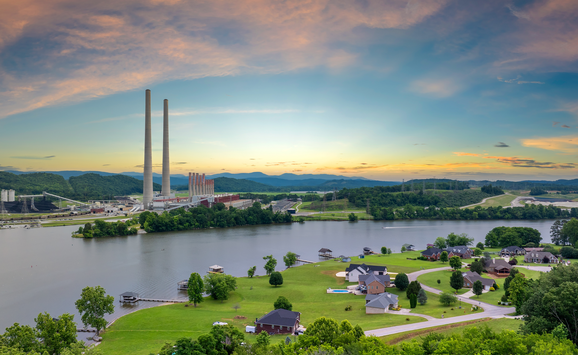The coming of age of nuclear power was revealed in the flood of 1966 announcements made by electric utilities concerning plans to proceed with the construction of atomic power plants. By the end of September plans for more than 17,000 megawatts of new nuclear plant additions had already been announced. This total was more than three times as much as the 5,500 megawatts of planned nuclear capacity additions announced to during the entire year in 1965.
The 1966 total is impressive not only for its size, but also in comparison with plans for fossil-fuel-fired capacity additions. Nuclear capacity accounted for about one-half of all of the planned steam-electric plant additions announced during the first nine months of 1966, while conventional fossil fuel plants made up the remaining half. This is substantial change from 1965 when nuclear plants came to 25 percent of planned steam-electric capacity additions announced, and fossil fuel plants to 75 percent.
An outstanding characteristic of the planned nuclear plant addition is their geographic diversity. Atomic power plants proposed for completion by 1973 are to be found in many regions of the country, including those in which the cost of coal is quite low. Probably the outstanding example in the latter category was the June announcement of the Tennessee Valley Authority that after a detailed comparison of coal-fired and nuclear power plants it had placed orders for two nuclear units totaling more than 2,000 megawatts to be located in Alabama. The TVA, which in 1965 generated about 75 percent of its electricity from coal, is located close to major coal fields and enjoys fuel costs well below the national average.
On the other hand, a good quarter of the conventionally fired plants announced during the year consists of installations to be located not in traditionally coal-burning states but in the intermountain region, attesting to an even more radical shift in fuel pattern than is suggested by the aggregate statistics.
The record of announcements of plans and orders in 1966 tends to bear out the promise of economically competitive nuclear power that was first indicated in the 1963 decision of Jersey Central to build the Oyster Creek nuclear power plant in southern New Jersey. The company's earlier detailed economic analysis indicated that for the first time a decision to build a nuclear power plant within the United States had been made in the expectation that it would be economically competitive.
The Oyster Creek plant is still under construction. With its completion and completion of the numerous plants ordered subsequently, competitive nuclear power should be available in many parts of the country. If all current plans result in physical installations, nuclear power within a few years should approach 5 percent of the nation's total electric utility capacity which, having risen by an average 12,000 megawatts per year in recent years, was about 235,000 megawatts in December 1965.
The development of competitive nuclear power would be a formidable technological achievement, following alternating periods of optimism and pessimism regarding commercial use in the two decades since the bomb was dropped on Hiroshima. As recently as 1963, just prior to the Oyster Creek announcement, the outlook for the early achievement of competitive nuclear power was highly uncertain. Oyster Creek appears to have been the decisive turning point. Since then orders for nuclear power plants have snowballed. This is all the more remarkable as they are based on the calculated expectation, not the accomplished demonstration, of competitiveness.
Government-supported research and development can claim major credit for bringing nuclear power technology to its present level. Now that competitive power appears within reach, the research and development program of the Atomic Energy Commission has set itself a new goal: economic nuclear power plus greatly improved efficiency in the use of nuclear fuels. Uranium as it occurs in nature contains only a small amount of fissionable material—approximately 1 part in 140. Nuclear power technology, as presently developed, essentially uses not much more than this small fraction of naturally fissionable uranium. This would not be a matter for concern if uranium were as omnipresent as water. But it is not nearly so common, and the prospect of a rapidly growing reactor capacity has led to a lively debate on the adequacy of uranium resources.

In theory, it is possible to convert all of natural uranium into fissionable materials. In an appropriately designed nuclear reactor that portion of uranium which is naturally inert—uranium-238—can be converted into fissionable plutonium at the same time the reactor is consuming its existing fuel to generate energy. In addition, thorium, which is naturally inert, can similarly be transmuted into fissionable uranium-233 in an appropriately designed reactor. If these theoretically possible conversions were to be achieved in a commercially feasible reactor, the natural resource base available to the future nuclear power industry would be multiplied enormously.
The transmutation of inert uranium-238 and thorium (the so-called fertile materials) into fissionable plutonium and uranium-233 can be achieved in varying degrees. One possibility is to design a reactor which generates energy and at the same time produces a quantity of new fissionable materials greater than the quantity consumed in sustaining the reaction. This is called a breeder reactor because not only is enough new material produced to replace what has been consumed in generating energy, but also an additional amount with which to fuel new reactors.
Development of a commercially feasible breeder reactor would be the ultimate achievement in nuclear fission, for it would yield economically competitive nuclear energy and the most efficient use of nuclear raw materials. This is the goal that the Atomic Energy Commission is now pursuing.
At the present time the primary emphasis of the Commission is on establishing a firm technological base for the commercial breeder reactor. The Commission's expectations are that the first commitments for the construction of demonstration breeder plants will be made around 1970. It is thought that, just as in the development of today's reactor technology, construction of these demonstration breeders will be cooperative ventures of utilities, reactor manufacturers and the Commission, presumably heavily funded by the federal government. When and whether the commercial breeder will be achieved, and by which technical routes and with how much government financial support, are questions that will be answered by the results of public policy debate.
If the emergence of nuclear power as a competitive energy source has settled the argument over the timing of its "coming of age" and given increased impetus to the achievement of more efficient raw material use, it also poses more forcefully the question of radioactive waste disposal, especially of the so-called high-level wastes that result from chemical processing of fuel irradiated in nuclear power plants; these take hundreds of years to decay to safe levels of radiation. There is no experience in handling such types of waste on the scale now coming into view: several tens of millions of gallons of this highly dangerous material in liquid or solid form between now and the end of the century.






